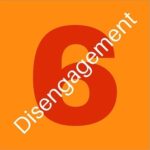 Welcome to the sixth and final of a series of ways in which employees can take responsibility for their own engagement. As we established in the introductory post, “An Employee’s Guide: 6 Ways to Better Engagement in the Workplace,” employees assume some measure of responsibility for their own engagement. Engagement is a choice.
Welcome to the sixth and final of a series of ways in which employees can take responsibility for their own engagement. As we established in the introductory post, “An Employee’s Guide: 6 Ways to Better Engagement in the Workplace,” employees assume some measure of responsibility for their own engagement. Engagement is a choice.
We have already considered mindfulness (awareness), and the importance of sleep, nutrition, exercise and learning. In this post, we will look at the sixth way to better engagement in the workplace: Strategic Disengagement.
About strategic disengagement
When discussing employee engagement, we are always targeting those that are disengaged. We’ve learned from Gallup that disengagement costs the US Economy approximately half a trillion dollars in lost productivity each year.1 The root cause of disengagement is related to the unmet needs of the individual employee: They are micro-managed and thus lack the autonomy they desire in their work; They aren’t given learning and development opportunities to maintain and grow their skills; They aren’t recognized and rewarded for the work they do; etc.
It is interesting to note then, that disengagement is required to be more engaged. In this case, disengagement is a strategy to take time away from your work so that you can return more refreshed, re-energized, and better able to focus.
“The term “Strategic Disengagement” comes from the Johnson & Johnson Human Performance Institute, which studied world class athletes as a way to better understand how to make world class employees (referred to as “Corporate Athletes”).
What they found, which will be no surprise to athletes, is that you reach peak performance not by exhausting yourself 100% of the time, or by sitting around doing nothing, but in oscillating between energy expenditure (such as working out) and energy renewal (resting).”2
Benefits
“[O]ne of the biggest problems plaguing today’s organizations is something that is pervasive, invasive, and preventing your top people from achieving their personal and professional best.”3
“[The Human Energy Crisis] a result of ever-growing demands on our time, our bodies, and essentially our energy. In a world where we are expected to perform 24/7, the pressure is not only daunting, it can be debilitating. In fact, the pressure to perform never dissipates; it often increases. As such, when demand persistently exceeds capacity, negative consequences are inevitable to business, body, and home-life alike.” 4
By taking time to strategically disengage, you can avoid the following5:
- Persistent fatigue
- Suboptimal performance
- Disengagement (unmet needs)
- Low tolerance for stress
- Low resiliency
- Work/life imbalance
- Loss of focus
- Judgment errors
- Leadership failure
How can you better focus on strategic disengagement?
“Strategically disengaging means establishing habits which help you intentionally recuperate– mind, body and spirit– over the course of your day (and your life). On a day-to-day basis, this can be done through the routine acts that give you energy, such as eating well, exercising, practicing good sleep hygiene, or using your larger mission to guide how you spend your time. Even those actions which are fewer and further between have their role: getting a monthly massage, taking a bi-yearly retreat completely away from email, or engaging in an altruistic, life-giving project within your community.”6
Ready to strategically disengage right now? Check out Humor That Work’s laugh page or visit their sister site on office humor.
The role strategic disengagement plays in engagement
“Energy, not time, is the fundamental currency of high performance.”7 “Because energy diminishes both with overuse and with underuse, we must balance energy expenditure with intermittent energy renewal.”8
To be at your best, incorporate strategic disengagement into your daily routine. This renewal process will allow you to be better focused, more productive, make better decisions, and lead more effectively.
What are your thoughts on strategic disengagement? In what ways do you strategically disengage?
1 “State of the American Workplace.” Gallup.com. Gallup, Inc. Web. 18 Feb. 2016. <http://www.gallup.com/strategicconsulting/163007/state-american-workplace.aspx>.
2 Tarvin, Andrew. “What Is Strategic Disengagement?” What Is Strategic Disengagement? Humor That Works, 3 Dec. 2012. Web. 07 July 2016.
3 “Human Energy Is The Most Critical Resource Businesses Have. Period.” Solving Energy Problems for Leaders to Enhance Human Performance. Johnson & Johnson Human Performance Institute, n.d. Web. 07 July 2016.
4 Ibid.
5 Ibid.
6 Moorefield, Renee. “Sometimes the Best Way to Engage Is to Disengage -.” Wisdom Works. Wisdom Works Group, 29 Aug. 2011. Web. 07 July 2016.
7 Johnson, Brian. “The Power of Full Engagement.” Experience Life. Philosophers Notes, Nov. 2011. Web. 7 July 2016.
8 Ibid.
Let’s Engage!
I’m Agent in Engagement Simpson…Gregory F Simpson.
Employee engagement is a critical mission. I hope I can count on your help! Subscribe to the RSS Feed to receive the latest intelligence/insights and/or register to make entries in the comments log.
 You can follow me @agtinengagement.
You can follow me @agtinengagement.
Email me at g…@a…t.com.
Connect via LinkedIn at LinkedIn.com/in/GregoryFSimpson.
Learn more about me at gregoryfsimpson.com.
P.S. First contact? Welcome to the Agent In Engagement community. Explore and join fellow employee engagement operatives in targeting a known thief – alias: Disengagement. Together we can bring this thief to justice and make the world a better place for all companies and their employees.
Other recent Agent in Engagement data/reports by Agent Gregory F Simpson:
- Employee Engagement Intelligence Briefing: 2016.06.27 – 2016.07.01
- Veteran Operative Employee Engagement Insights: 06.27 – 2016.07.01
- The Fifth Way to Better Engagement in the Workplace
- The Fourth Way to Better Engagement in the Workplace
- The Third Way to Better Engagement in the Workplace
- The Second Way to Better Engagement in the Workplace
- The First Way to Better Engagement in the Workplace